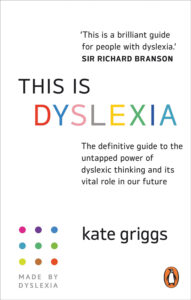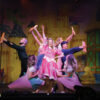
by Kate Griggs
Made By Dyslexia
How can you tell a child is Made By Dyslexia? As many as 1 in 5 children are dyslexic but research suggests that 80% of dyslexic children leave school without being spotted. This proves that in order for parents and teachers alike to spot, support and empower dyslexic children, there needs to be more awareness about what the signs of ‘Dyslexic Thinking’ are.
Dyslexic brains are wired slightly differently, which means they have a different way of processing information. This difference results in a pattern of challenges, but extraordinary strengths too.
Children with dyslexia have trouble learning to read, write and spell as well as remembering lots of facts and figures or concentrating and following instructions. Tests are particularly tricky for dyslexic children as they are a combination of all these things and can make them feel embarrassed or even stupid, which they are not! This can make school particularly frustrating for dyslexic children. But if spotted early, and given the right support, they can and will do well.
How to spot your child’s dyslexic superpower
• Think about what your child loves to do and would do for hours, if left to their own devices. These are usually their ‘Dyslexic Thinking’ skills.
• Find out what they are passionate about, what they love to talk about, watch or learn about.
• Encourage them to do both of the above, lots and lots. Skill + practice + passion = superpower.
• Easy-to-spot strengths include sport, art, music and dancing. But empathy, kindness, imagining, listening and questioning are all incredibly valuable superpowers too.
• Acknowledge their expertise. Dyslexics often don’t realise how good they are at these things, so may not recognise them as their superpowers.
To identify ‘Dyslexic Thinking’ skills in children, we conducted one of the largest research projects of its kind. Our extensive research with dyslexic people, teachers, psychologists and parents, helped us to gather a unique insight into dyslexic strengths and thinking skills in children. These are the things that dyslexic children are naturally good at, and love to do. Because they love to do them so much, they practise them a lot and become extraordinarily good at them and these things become their ‘superpowers’.
From this research, we developed seven dyslexic archetypes:
1. Storytellers
2. Makers
3. Entertainers
4. Movers
5. Imaginers
6. Questioners
7. ‘People’ people
Dyslexic children have a natural ability in some or all of these seven archetypes. While all children will show ability and interest in these areas, dyslexics tend to immerse themselves and become very good, often ‘expert’ at them. You can develop resilient confident learners by nurturing these natural abilities, which can develop into valuable skills in work and life.
Here are some of the signs for each dyslexic archetype in children:
• Storytellers:
Persuasive. Tell tall tales. Elaborate explainers. Invent stories. Love stories and films. When they grow up, Storytellers often become journalists, teachers, writers, filmmakers, politicians or campaigners.
• Makers:
Jigsaws. Puzzles. Lego. Building things. Making things. Cooking. Crafts. Art and painting. When they grow up, Makers often become architects, craftspeople, chefs, designers, gardeners, artists or programmers.
• Entertainers:
Music and rhythm. Singing. Dancing. Jokers. Expressive arts. Like putting on a show. When they grow up, Entertainers often become actors, musicians, comedians, salespeople, PR people or presenters.
• Movers:
Fidgets ‘on the go’. Physical risk takers. Sports/ball skills. Balance. Climbing. Skateboarding. Gymnastics. When they grow up, Movers often become musicians, sportspeople, dancers, sports coaches, choreographers or firefighters.
• Imaginers:
Daydreaming. Making up games and fantasy/imaginary worlds. Create dens and ‘worlds’ out of things. Get lost in their imagination, immersed in activities. When they grow up, Imaginers often become scientists, inventors, entrepreneurs, artists, actors, photographers or filmmakers.
• Questioners:
Constantly ask ‘what if?’ and ‘why not?, Challenge norms and rules. Have an answer for everything. Always curious. Problem-solvers. Explain things to everyone. When they grow up, Questioners often become detectives, spies, entrepreneurs, journalists, writers or real change-makers.
• ‘People’ people:
Peacemakers. Social organisers. Busybodies. Helpers. Charmers. Carers. Leaders. When they grow up, ‘People’ people often become nurses, doctors, teachers, care workers, managers or presenters.
So, by far the most important thing we can do for any dyslexic child is to identify their strengths and place as much importance on them
as we do on their challenges. With help, our children will learn to do all they need to do well enough, but it’s their dyslexic strengths that will help them to excel in life.
Early identification and the right support is vital for dyslexic children, so that’s why Made By Dyslexia has created our free online dyslexia awareness training films, so parents and teachers around the world can gain the knowledge they need to begin to support their children.
Kate Griggs is the founder and CEO of global charity Made By Dyslexia and author of dyslexia guide This is Dyslexia (Penguin, £11.99) and children’s book Xtraordinary People: Made By Dyslexia (Penguin, £6.99).












